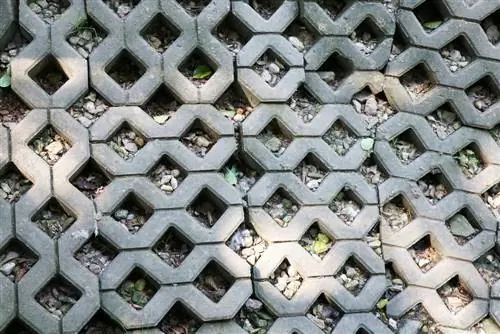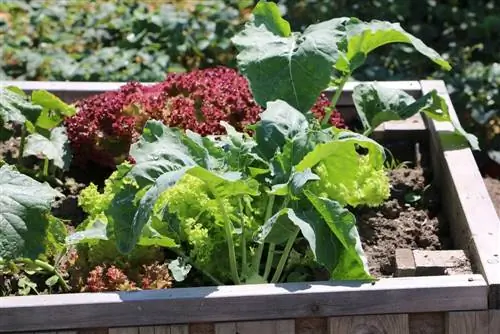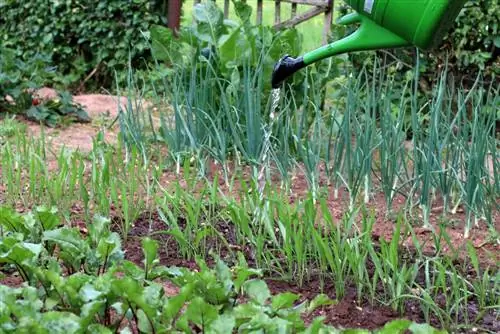- Author admin [email protected].
- Public 2023-12-17 03:39.
- Last modified 2025-01-24 12:45.
If you grow vegetables in your own garden in summer, you usually do so in beds. In order to be able to reach the beds for watering the plants, weeding or harvesting, appropriate access is usually required. After all, it makes little sense to walk through the middle of a well-cultivated bed. Consequently, ways are needed that, among other things, make it easier to care for the plants.
Pathways
Yes, a vegetable garden also needs to be planned - at least if you want to grow more than just one or two types of vegetables. When planning, the first thing of course is the beds, their location and size. However, you should not forget that the beds also have to be reached. Ways are needed for this. Basically, three types of paths can be distinguished:
- Main routes
- Accessions
- Care Pathways
Main routes are something like the major arteries in a vegetable garden. For example, you can use them to bring a wheelbarrow as close as possible to a bed. Accesses are the branches from a main path that lead from there directly to the bed. Finally, maintenance paths are those small paths on which you can move within the bed without having to step on plants. How many of these individual paths are required depends, of course, on the size of the vegetable garden and the number of beds. What all types of paths have in common is that they are intended to make accessibility easier. And if possible, they should also look good.
Tip:
When planting a new vegetable garden, it is advisable to draw a plan in which the number of beds is recorded. Based on this, the paths actually required can then be derived.
Main routes
As already indicated, the main path or paths are the central supply artery in the vegetable garden. It makes sense if, for example, they lead directly to a tool shed or to the compost. Since somewhat heavier garden equipment is usually transported on these paths, they should definitely be secured. It is also important to ensure there is sufficient width. It should be at least 60 cm. Main routes can be designed in many ways. There are hardly any limits to your own creativity. Here are a few ideas and basic possibilities:
Paving stones
A paved path guarantees that you can get exactly where you want to go with dry feet and very safely. It is therefore a good idea to pave the main path in the vegetable patch because it can then easily be used with a wheelbarrow, for example, even when it is wet. However, in order to pave the path, the path must first be excavated and then a stable substructure on which the stones can rest. Which type of paving stones you choose depends on your personal taste and budget. Slabs made of natural stone or exposed concrete are recommended. In any case, attractive visual accents can be set with both materials. Disadvantage: Further sealing of the floor.
Tip:
Washed concrete slabs can be easily painted in all conceivable colors. This means that such a path can be designed extremely individually.
lattice stones

In order to largely avoid floor sealing, you can use so-called lattice stone. On the one hand, they form a stable path that can be used even when it is wet, but on the other hand, their openings ensure that the water can drain into the ground. Grid blocks are now available in hardware stores in countless shapes, colors and designs. They also require a substructure.
Gravel/Gravel
A path can also be paved very reliably with gravel or gravel. Both materials also appear very close to nature and natural. Gravel is available in many different grain sizes and colors. This means that a variety of design options are no longer a problem. The disadvantage of both building materials, however, is that the path has to be maintained much more frequently.
Specifically:
The stones have to be pulled smooth again and again.
Delimitations
It makes sense not only to pave the main path, but also to separate it from the beds. In this context, people often talk about a path or bed border. On the one hand, this ensures that the fertile soil in the beds cannot get onto the path, and on the other hand, it prevents you from accidentally stepping into the beds or rolling into them with a wheelbarrow. There are also countless variations of path borders. Elongated stone slabs are just as much a part of this as small stone walls or wooden palisades. The latter are particularly recommended because they look extremely natural. The palisades are simply hammered into the ground with the pointed side. The situation is similar with metal sheets. Stones, on the other hand, should best rest on a foundation.
Accessions
As branches off the main path, the entrances lead directly to the bed. They can, but do not have to be, attached. A grass path, for example, would also be possible, which would then fit perfectly into the natural landscape. But a sand or gravel path is also conceivable. Of course, there is nothing wrong with paving the entrances. Only additional sealing should be avoided if possible. If the main path has a path border, the branches to the entrances must of course remain free, otherwise you regularly have to overcome a completely unnecessary barrier. Incidentally, the width of the access plays a minor role. The only important thing is that you can move safely and comfortably on it.
Care Pathways
The care paths lead right into the middle of the bed. They make it possible to work directly on the individual plants and of course also harvest them. A width of around 15 to 20 cm is usually sufficient. It is best to plant them by tamping down the soil in a straight line between the rows of plants. In the vast majority of cases, a single care path is sufficient, which then completely cuts through the bed. It makes sense that the path is a little deeper than the raised planting area. You should also move on it with a certain degree of caution so as not to damage any plants. A special design is not recommended. Functionality is what counts most here. Design elements can quickly become a hindrance.
More tips

The paths in the vegetable garden don't necessarily have to be dead straight. The main path, for example, can also be designed very well in a serpentine line, for example. However, this requires significantly more effort and of course also has an impact on the shape of the beds. But who says they always have to be in the shape of a rectangle? Why not experiment with other shapes?
Using leftovers
For the design of the main path and the entrances, it is advisable to use leftover materials, for example from paving the garage entrance. This not only saves costs, but also conserves resources. Stones that have already been used can also be used wonderfully for this purpose. However, it is advisable to clean them thoroughly beforehand. By the way, old roof tiles can also be used as a path border. These can be carefully hammered into the ground with a rubber mallet. Old wooden planks and square timbers are also suitable for this.
Care
The paths in the vegetable garden should also be maintained. The main path will almost certainly need to be swept regularly. It is also advisable to clear it of weeds several times a year, which can grow out of even small gaps. Otherwise, the natural seed flight runs the risk of increased weed formation in the beds. The paths do not have to appear licked, but should generally be clean. For safety reasons, it is advisable to repair any defects immediately.






